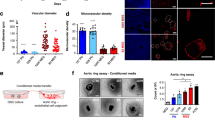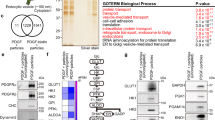Abstract
Gangliosides have been proposed as modulators of transmembrane signaling. Recently, GM3, a glycosphingolipid containing monosaialic acids, is thought to be one of the key molecules of signal transduction in mammalian cells. In this study, we used mouse embryonic fibroblast cell lines (MEFs) established from sialyltransferase-I knockout mice (GM3 synthase KO mice) to evaluate the regulation of mitogenic signals by gangliosides. Cell proliferation assay revealed a higher growth potential of GM3 KO MEFs. Immunoblots showed upregulation of Ras/Raf/MEK/ERK pathway in GM3 KO MEFs, and these signals resulted in enhanced translocation of ERK into the nuclei. Further, both exogenous and endogenous add-back of GM3 decreased the activities of MAPK in GM3 KO MEFs. In addition, GM3 KO MEFs formed foci in high-density culture condition, and analyses of cell cycle modulators revealed the resistance of GM3 KO MEFs for entering cell cycle arrest. Finally, sustained expressions of c-Fos in GM3 KO MEFs were shown to correlate with DNA-binding activity between c-Fos and AP-1. These results demonstrate that the deletion of sialyltransferase-I changes the character of MEFs to a highly activated state of the MAPK pathway, indicating the critical role of GM3 as a regulator of membrane-transmitted signals.
This is a preview of subscription content, access via your institution
Access options
Subscribe to this journal
Receive 50 print issues and online access
$259.00 per year
only $5.18 per issue
Buy this article
- Purchase on Springer Link
- Instant access to full article PDF
Prices may be subject to local taxes which are calculated during checkout






Similar content being viewed by others
References
Ballif BA, Blenis J . (2001). Cell Growth Differ 12: 397–408.
Blagosklonny MV . (1999). BioEssays 21: 704–709.
Cobb MH, Goldsmith EJ . (1995). J Biol Chem 270: 14843–14846.
Cullen PJ . (2001). Curr Biol 11: 342–344.
Danen EH, Yamada KM . (2001). J Cell Physiol 189: 1–13.
Deng C, Zhang P, Harper JW, Elledge SJ, Leder P . (1995). Cell 82: 675–684.
Dignam JD, Lebovitz RM, Roeder RG . (1983). Nucleic Acids Res 11: 1475–1489.
Fu M, Wang C, Li Z, Sakamaki T, Pestell RG . (2004). Endocrinology 145: 5439–5447.
Galbiati F, Volonte D, Engelman JA, Watanabe G, Burk R, Pestell RG et al. (1998). EMBO J 17: 6633–6648.
Garofalo T, Sorice M, Misasi R, Cinque B, Mattei V, Pontieri GM et al. (2002). J Lipid Res 43: 971–978.
Gorbacheva VY, Lindner D, Sen GC, Vestal DJ . (2002). J Biol Chem 277: 6080–6087.
Gouni-Berthold I, Seul C, Ko Y, Hescheler J, Sachinidis A . (2001). Hypertension 38: 1030–1037.
Groth A, Willumsen BM . (2005). Cell Signal 17: 1063–1073.
Gum R, Wang H, Lengyel E, Juarez J, Boyd D . (1997). Oncogene 14: 1481–1493.
Hakomori S, Yamamura S, Handa AK . (1998). Ann NY Acad Sci 845: 1–10.
Hanai N, Nores GA, MacLeod C, Torres-Mendez CR, Hakomori S . (1998). J Biol Chem 263: 10915–10921.
Hashiramoto A, Sano H, Maekawa T, Kawahito Y, Kimura S, Kusaka Y et al. (1999). Arthritis Rheum 42: 954–962.
Hoffmann E, Thiefes A, Buhrow D, Dittrich-Breoholz O, Schneider H, Resch K et al. (2005). J Biol Chem 280: 9706–9718.
Huwiler A, Kolter T, Pfeilschifter J, Sandhoff K . (2000). Biochim Biophys Acta 1485: 63–99.
Itano N, Atsumi F, Sawai T, Yamada Y, Miyaishi O, Senga T et al. (2002). Proc Natl Acad Sci USA 99: 3609–3614.
Iwabuchi K, Yamamura S, Prinetti A, Handa K, Hakomori S . (1998). J Biol Chem 273: 9130–9138.
Kawahito Y, Kondo M, Tsubouchi Y, Hashiramoto A, Bishop-Bailey D, Inoue K et al. (2000). J Clin Invest 106: 189–197.
Kolch W . (2000). Biochem J 351: 289–305.
Kono M, Takashima S, Liu H, Inoue M, Kojima N, Lee YC et al. (1998). Biochem Biophys Res Commun 253: 170–175.
Li A, Blow JJ . (2001). Nat Cell Biol 3: 182–184.
Li R, Liu Y, Ladisch S . (2001). J Biol Chem 276: 42782–42792.
Li R, Manela J, Kong Y, Ladisch S . (2000). J Biol Chem 275: 34213–34223.
Matyas GR, Aaronson SA, Brady RO, Fishman PH . (1987). Proc Natl Acad Sci USA 84: 6065–6068.
Monje P, Marinnisen M, Gutkind JS . (2003). Mol Cell Biol 23: 7030–7043.
Murphy LO, Smith S, Chen P, Finger DC, Blenis J . (2002). Nat Cell Biol 4: 556–564.
Nakatsuji Y, Miller RH . (2001). J Neurosci Res 66: 487–496.
Noll EN, Lin J, Nakatsuji Y, Miller RH, Black PM . (2001). Exp Neurol 168: 300–309.
Paller AS, Arnsmeier SL, Alvarez-Franco M, Bremer EG . (1993). Invest Dermatol 100: 841–845.
Radeff-Huang J, Seasholtz TM, Matteo RG, Brown JH . (2004). Cell Biochem 9: 949–966.
Scorrano L, Petronilli V, Colonna R, Di Lisa F, Bernardi P . (1999). J Biol Chem 274: 24657–24663.
Smart EJ, Graf GA, McNiven MA, Sessa WC, Engelman JA, Scherer PE et al. (1999). Mol Cell Biol 19: 7289–7304.
Suarez Pestana E, Tenev T, Gross S, Stoyanov B, Ogata M, Bohmer FD . (1999). Oncogene 18: 4069–4079.
Tanaka T, Yoshida N, Kishimoto T, Akira S . (1997). EMBO J 16: 7432–7443.
Van Brocklyn J, Bremer EG, Yates AJ . (1993). J Neurochem 61: 371–374.
van Meer G, Holthuis JC . (2000). Biochim Biophys Acta 26: 145–170.
Wang XQ, Sun P, O'Gorman M, Tai T, Paller AS . (2001). Gycobiology 11: 515–522.
Wang XQ, Sun P, Paller AS . (2003). J Biol Chem 278: 48770–48778.
Yamashita T, Hashiramoto A, Haluzik M, Mizukami H, Beck S, Norton A et al. (2003). Proc Natl Acad Sci USA 100: 3445–3449.
Zou Y, Hu Y, Metzler B, Xu Q . (1998). Int J Mol Med 1: 827–834.
Acknowledgements
Special thanks goes to Dr Richard L Proia for his kind support throughout this work.
Author information
Authors and Affiliations
Corresponding author
Rights and permissions
About this article
Cite this article
Hashiramoto, A., Mizukami, H. & Yamashita, T. Ganglioside GM3 promotes cell migration by regulating MAPK and c-Fos/AP-1. Oncogene 25, 3948–3955 (2006). https://doi.org/10.1038/sj.onc.1209416
Received:
Revised:
Accepted:
Published:
Issue Date:
DOI: https://doi.org/10.1038/sj.onc.1209416
Keywords
This article is cited by
-
Novel function of FAXDC2 in megakaryopoiesis
Blood Cancer Journal (2016)
-
TALEN mediated targeted editing of GM2/GD2-synthase gene modulates anchorage independent growth by reducing anoikis resistance in mouse tumor cells
Scientific Reports (2015)
-
Noninvasive imaging of sialyltransferase activity in living cells by chemoselective recognition
Scientific Reports (2015)
-
Molecular dynamics study of the conformations of glycosidic linkages in sialic acid modified ganglioside GM3 analogues
Glycoconjugate Journal (2014)
-
Multiple phenotypic changes in mice after knockout of the B3gnt5gene, encoding Lc3 synthase—a key enzyme in lacto-neolacto ganglioside synthesis
BMC Developmental Biology (2010)



